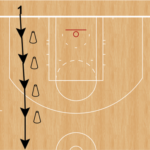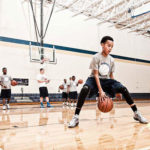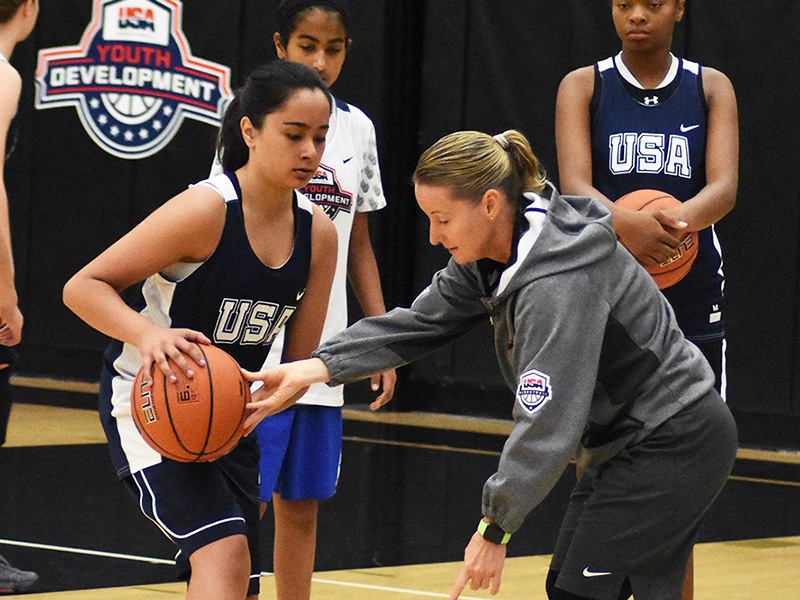Players at the youth level. The most crucial time for our players to properly develop. The players are at an age in their life where bad habits can quickly be reversed into good habits. As they get older and continue to repeat those bad habits or techniques, the harder it is to fix. So how do we approach developing our youth? A lot of youth coaches don’t understand how important their role is to making or breaking a player. The goal is to have them find joy for the game, learn, grow, and be on a path to continue their playing career to the next level. Not only do we want to educate them on the court, but more importantly, educating them off the court teaching life skills. Below, I will briefly outline how to develop youth basketball players on and off the court.
Step 1
On the court:
Just like a house, you want to begin with the foundation. A player is only as effective as the strength of their footwork. Establish a players footwork and build on it. Start without the basketball using agility drills to have the players become comfortable moving their feet in a variety of ways.
A few agility drills (use diagram for these 3 drills):
Line Jumps
Description
Players are positioned next to a line on the court.
The players will jump over the line laterally going continuously for 45 seconds.
Players will go in this sequence:
- Two feet jumps
- Right foot jumps
- Left foot jumps
- Two feet jumps
- There will be a 15 second rest period in between each set (4 sets total)

Scissor Jumps
Description
- Players are positioned next to a line on the court having their feet stagger the line (one foot in front, one foot back).
- The players will scissor step over the line going continuously for 45 seconds.
- Players will complete 3 sets.
- There will be a 15 second rest period in between each set (3 sets total).
Skii Jumps
Description
- Players are positioned next to a line on the court.
- The players will push off one foot trying to create space laterally, landing on the other foot on balance.
- Once the player lands on one foot, they will push off that foot laterally and land on the other foot on balance.
- Players will go continuously for 45 seconds.
- Players will complete 3 sets.
- There will be a 15 second rest period in between each set.
Step 2
As we continue to build on the foundation of the players footwork, we must incorporate body control. A lot of turnovers that occur in a game stem from players being out of control and not being strong with their footwork or body control. It is imperative to build the strength of their feet and body through drills and exercises that don’t require the basketball. I am not qualified in the strength & conditioning profession, but here a few on court drills I use to help continue building great footwork and body control.
Starts – Stops
Description
- Players start by accelerating to the next spot (cone), coming to a stop on balance.
- Players will repeat this until they finish sprinting to half court.
- Player will go continuously for 3 minutes.
Set up another line of cones if there are a larger number of players.
Arc Run
Description
- Players will start in a corner on the baseline.
- Players begin the drill by sprinting the arc of the 3-point line. They are trying to stay as close to the line as possible without going over.
- Once the player gets to the other corner, they are performing a ski jump in one direction back to the start.
- Ski jumps in one direction mean pushing off the outside foot, landing back onto two feet, and repeating (Ex. Push off left foot, land right foot/left foot, push off left foot again).
- Players will go continuously for 2 minutes before switching to the other side.

Games
To incorporate some fun into the session that allow players to work on their feet and body control, here are some games to think about using that can be beneficial:
- Tag (No ball)
- Relay race
- Partner chase
- Capture the flag (group setting)
Step 3
There are so many resources to find different drills for ways to improve footwork and body control. I am solely providing an outline of how I approach developing youth players ensuring they can be effective with the basketball. My saying is “feet, body, ball.” If a player can have great control of their feet and body, then they will have great control of the basketball in a variety of situations. 
Once I start to see continued progress in footwork and body control with the players I am working with, we will then progress to using the basketball within the sessions. I would generally spend the first 20 minutes with various exercises in steps 1 & 2 before involving the basketball. As we incorporate the basketball, we do not lose sight of the foundation that we are continually building.
Ball-Handling: Focus on feet and body in an athletic stance before going on the move. Ensure the players are strong within their foundation. Develop a players comfortability with both hands to be effective handling the ball with both.
Stationary
- Pound dribbles in an athletic stance
- Incorporate body movement within a stationary position
- Incorporate feet movement staying in the same space
On the Move
- Handling the ball under control in straight lines
- Changing directions
- Being able to change speeds in straight lines and changing direction
Once the player becomes comfortable in these areas, adding “go-to” moves would be best at a time where the moves can be effective. Too often do we provide players with moves where they won’t translate to games because they are not comfortable making those movements even without the ball. Develop a players full control for their feet, body, and the ball before progressing to moves.
Passing: Focus on the players having a comfort using both hands. Be able to pass with both from a strong athletic position before progressing on the move.
Stationary
- Nash passing (one hand). Working on accurately and efficiently passing with both hands.
- Developing the ability to pass off the dribble.
On the move
- Nash passing. Stepping with the same side foot towards where the player is passing.
- Passing off a jump stop. Ability to drive, play under control, and pass to teammates.
Triple Threat and Pivots: Developing being strong with the ball, having great ball protection, and playing under control with great footwork.
- Establish comfort using both feet as a pivot.
Finishing: Controlling the feet and body leads to having great control of the ball.
- Establish touch around the rim getting a feel for the ball using and not using the glass before adding in footwork.
- Footwork breakdowns: focus on just the footwork and the touch before adding in the dribble.
- Finishing breakdowns: Add in one or two dribbles with the footwork and touch. Progress with the difficulty of each finish.
Shooting: Establishing footwork, rhythm, balance, and flow to be able to consistently shoot the ball from various spots on the floor.
- Form Shooting
- FLOW Shooting: One motion from shooting pocket to finish.
- Balance Shooting: Establish control of feet and body to effectively FLOW shoot.
- Footwork: Developing shot ready footwork stepping into the catch (receiving a pass from a teammate).
- Right handed shooters: Left foot/right foot
- Left handed shooter: Right foot/left foot
- Spot Shooting: Progressing with shot ready footwork from various spots on the floor.
- Relocation Shooting: Progressing with shot ready footwork on the move.
Driving, Passing, and Movement: Developing an understanding for spacing and moving with the drive and sharing the ball in game spots.
Step 4
I have briefly outlined how to be progressive with youth players and their development. We have not even discussed players playing against defense or implementing the defensive side of the ball. I have seen players at the 3rd and 4th grade levels going through SHELL defense and it made me nauseous to watch. Youth players need to develop a joy for the game, their foundation of feet and body, and then their fundamentals to be effective. I understand that all players develop at faster rates than others dependent on their commitment to the game, but they all must go through a very similar process to have any longevity playing competitively. Once defense is added, we can then begin to teach both sides of the ball. Begin individually and build to team concepts. I use small sided games to effectively help players translate their skills to game situations.
Small Sided Games:
- 1v1: Begin teaching individual defense and making plays offensively versus a defender
- Defense: Containing the ball without fouling. Recovering when the offensive gets an advantage.
- Offense: “Go-to” moves to attack and gain an advantage. Being able to drive and finish through contact.
- 2v2
- Begin teaching help side concepts and how to guard cuts, screens, kick outs on defense.
- Offensively, begin teaching 2-man concepts creating advantages versus the defense to score.
- 3v3
- Begin teaching defensive rotations.
- Creating 3v2, 2v1 advantages on offensive.
- 4v4
- Begin to teach defense in SHELL.
- Passing, cutting, screening, drive & kick offensively.
- 5v5
- Begin in the half-court before progressing full-court.
Once you are able to build up to 5v5, you have now established being able to effectively have your players play in a game-like setting. As you progress with game situations, players continue to build on their foundation through progressive skill development.
Note* Players at the youth level should be focusing more on their skill development than game play (65%/35% ratio).
To have access to the full Youth Player Development Book, click the link below!
http://www.coffeenhoops.com/shop
Step 5
Along with players developing on the court, off-court development is of the upmost importance. As coaches, our platform is not just used to teach the game of basketball, but teach life! Life-skills are so engrained with our sport and we must ensure that we are doing our job to develop our youth into young respected adults.
Off the Court:
If players are able to find joy with the game, then they must be able to control their attitude and effort. Having a great attitude and bringing great effort are not just for the basketball court, but it needs to be an approach to every day life. In order for players at the youth level to find joy and have a positive mindset to the game and life, we as coaches must bring positive reinforcement and be encouraging with everything they do on the court. Spread joy and positivity. Preach respect.
Here are a few things I do to help grow players off the court during workout sessions or practices:
- Players must shake hands and introduce themselves with players they do not know if they are in a workout session or try-out. Develop comfort within the whole group.
- Players must be dressed properly and have shoes tied before beginning a session. Look good, play good.
- If the coach calls the group in, they must run in right away. Develop sense of urgency.
- Set the tone with energy and demand it to spread throughout the group. The session is guaranteed to be more effective.
- Give ownership to the players. Put them in a position where someone has to take a leadership role. Whether that is teaching a drill to the group or having players lead the warm up, this gives the players a sense of control and a different voice for the group to hear aside from the coach.
- Get in, get better, get out mentality. Once the session begins, players will be held accountable for not wasting time. Players will be encouraged to perform each rep to the best of their ability and maximize their time and efforts. No regrets. Preach attitude and effort.
- Have players encourage one another. When in a workout or a practice, players must help one another get better being a great teammate. If everyone is encouraging one another to be the best they can, then everyone is getting the most out of the workout/practice. Be effective individually and collectively.
- When the session or practice comes to an end, make sure the players leave the gym the same way when they entered. Leaving trash or basketballs creates a messy work environment and is a sign of disrespect. Respect and values are huge life skills to teach players.
Youth basketball player development is where it all begins to build a future generation of student-athletes. We have heard the saying “it’s not how you start, it’s how you finish.” However, with youth players, it’s our job as coaches to be give them a great start to their development putting them on the correct path to maximize their potential on the court and be successful young adults off the court. Establish a foundation, build it up, and allow them to grow over time.


